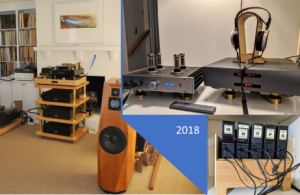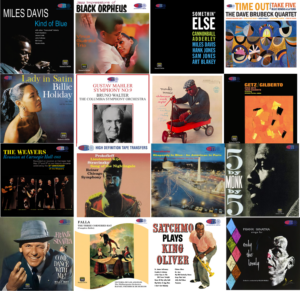Roger Skoff writes about cost and value in high-end audio

Roger Skoff, a portrait. LAOC Audio Society Gala, 2018 (photograph and image processing by David W. Robinson)
Note to our readers: Roger Skoff has been writing essays about high-end audio for years at Positive Feedback. Roger was formerly the founder and CEO of XLO Cables, and is now the CEO and founder of a new high-end cable company, RSX Technologies. You should be aware of this as you read his essay. Our guiding principle is that full disclosure equals no conflict of interest.
I still own a pair of High-End stereo amplifiers from one of our industry's greatest solid-state designers. Nearly thirty years ago, when I bought them, their suggested retail price was $5500 each—quite expensive for the time—and even by today's standards they're still quite good.
They also, even by today's standards, are quite beautiful and quite high-performance. Featuring 180 watts of balanced output per channel, fully differential circuitry throughout (both input and output), ½" (12.7mm) thick titanium-finished machined aluminum faceplates, matching extra-heavy custom-machined aluminum "lift-handles," etched and filled markings, and a lovely flush-mount two-stage pilot light, they are both electronically and visually outstanding.
When I first got them, I was writing for Sounds Like... Magazine and Sounds Like...News, and I was so pleased that I called the designer to compliment him—particularly on the faceplates and handles (I had already been using his gear for years, so the great performance was no surprise.) What was a surprise was when he told me that those pretty cosmetic pieces had cost him US $200 per amplifier!
Given the fairly normal "all industries" markup-from-parts-cost of 5 to 1 (the MSRP of the product is five times its cost of parts), that meant to me that those fancy faceplates and handles had added at least a full $1000 to the cost of each amplifier!
When I asked the designer about that effect on pricing, he confirmed it. And, when I asked, further, if he might not sell more amplifiers if he used an ordinary sheet metal faceplate and off-the-shelf handles and priced the amps nearly a thousand dollars cheaper, he told me no; at that price, with that kind of appearance, he might not sell any at all!
His logic was simple and probably correct: Even if the price could have been brought down to just $4500 apiece, the amplifiers would still have been expensive for their time, and without looking as expensive as they were (which, with cheap faceplates and handles, they wouldn't have), who, other than some small number of all-out performance-crazies, would have wanted to buy them? For most people, looks or the often-cited "Wife Acceptance Factor" (WAF) really do play an important part in the buying decision.
Products like high-end audio are typically made by small, highly specialized companies. That, just in itself, is a strong force in making them expensive: Small companies are typically low-volume companies, selling their products in less than "mass-market" quantities and, therefore, needing only small amounts of parts and services to produce them. That can, and does, make them more expensive in any (or even all) of four ways:
First, because they are only using small amounts of parts, they must either buy them at higher, non-negotiated prices, which increases their direct parts cost, or buy and inventory more parts than they need at any given time, which both increases the companies' total capital requirement and reduces their return-on-investment. It's the same for many services: Because they don't need all that many, they need either to hire outside people to provide them at higher-than-inside prices, or they must put people on company staff whose services may not be able to be fully utilized, but still must be fully paid-for.
The second reason is because, at their limited volume of sales, the specialist companies—even if they were to use parts and circuitry absolutely identical to those of the mass-marketers—could never buy those parts or engineer those circuits as cheaply as the larger companies do. That means that they can never effectively price-compete with them, but must, instead, charge more and compete in other areas: performance, appearance, or features.
Third, to offer better performance, better appearance, and/or more or better features means that either better parts must be used (themselves likely coming from higher-cost specialty companies), or better or more skilled engineering will be required—all of which cost more money, and must ultimately result in higher-priced products.
And finally, one of the basic principles of economics, price elasticity of demand, holds that (except under very special circumstances), "The higher the price of any good, the fewer units of that good will be taken." The result of it is that high-end audio is caught in what seems to be a "vicious circle," where low volume of sales leads to higher costs, which leads to higher prices, which leads to lower sales, which leads to efforts to sell more products by increasing performance, improving appearance, or adding features, which raises costs, which raises prices, which lowers the number of units sold, and around and around, again.
So, is high-end audio worth what it costs? Frankly, it all depends on the product and the company that makes it. Regardless of the nostalgia of audiophiles who dream fondly of the great products of yesteryear, there really has been tremendous progress in the sound of much of the new gear available to us. Competition DOES constantly work to make products more appealing to their potential buyers, and that really has resulted in some truly great things.
Where it gets complicated, though, is in that phrase "more appealing." Manufacturers who can't compete price-wise DO offer other things, instead—better performance, better cosmetics, or better or more features. Any or all of those things might help them to justify their products' expense and enhance their appeal to potential buyers. Not all of them, though, are always of real value to everyone.
Some features, for example, regardless of how good they are, may never be used. (I have four high performance SACD players, for example, that, because I have no SACDs, I use for CD only.) Other things, like super-exotic finishes on speaker enclosures or connector shells, strange-looking or oversize tubes on "valve" electronics, or ultra-elaborate "city-of-the-future" turntable setups—may certainly help to bring a product's appearance up to or beyond its price-point, but may actually contribute little or nothing to its actual performance.
What it's worth is up to you. Unless it's the result of outright greed and price-gouging (something that does happen, but never lasts past the point when the word gets around), the high price for a piece of high-end gear is probably just what it needs to be in order to keep the company in business, bringing you new things to buy and enjoy. As to whether any particular product is worth the money, high-end audio products, by their very nature, must offer a combination of performance, appearance, and features, and different companies (and even different products within a single company line) offer those things in different proportions, always intending to appeal to the greatest number of the people they identify as their market and at their price point. If they've guessed close enough to make you want to buy whatever it is that they're selling, then, for you, the product is worth the price. If not, then it isn't.
It's that simple.

































